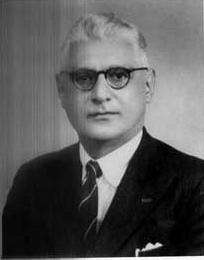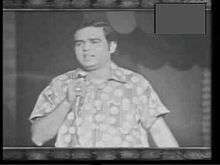Qaumi Taranah
| National Anthem | |
 | |
|
National anthem of | |
| Lyrics | Hafeez Jullundhri, June 1952 |
|---|---|
| Music | Ahmad G. Chagla, 21 August 1949 |
| Adopted | 13 August 1954 |
| Relinquished | Present |
|
| |
| Music sample | |
| Qaumi Taranah (Instrumental) | |



The Qaumi Taranah (Urdu: قومی ترانہ, Qaumī Tarānah pronounced [ˈqɔː.mi ˈt̪ə.rɑː.nɑ], lit. “National Anthem”), also known as Pāk Sarzamīn (Urdu: پاک سرزمین, pronounced [ˈpɑːk ˈsər.zə.miːn], lit. “The Sacred Land”), is the national anthem of Pakistan. Its music was composed by Ahmad G. Chagla in 1949, preceding the lyrics, which were written by Hafeez Jullundhri in 1952. It was officially adopted as Pakistan's national anthem in August 1954[1] and was recorded in the same year by eleven major singers of Pakistan including Ahmad Rushdi, Kaukab Jahan, Rasheeda Begum, Najam Ara, Naseema Shaheen, Zawar Hussain, Akhtar Abbas, Ghulam Dastagir, Anwar Zaheer and Akhtar Wasi Ali.[2][3]
History
In early 1948, A. R. Ghani, a Muslim from Transvaal, South Africa, offered two prizes of five thousand rupees each for the poet and composer of a new national anthem for the newly independent state of Pakistan. The prizes were announced through a government press advertisement published in June 1948. In December 1948, the Government of Pakistan established the National Anthem Committee (NAC) with the task of coming up with the composition and lyrics for the official national anthem of Pakistan. The NAC was initially chaired by the Information Secretary, Sheikh Muhammad Ikram, and its members included several politicians, poets and musicians, including Abdur Rab Nishtar, Ahmad G. Chagla and Hafeez Jullundhri. The NAC encountered early difficulties in finding suitable music and lyrics.
When President Sukarno of Indonesia became the first foreign head of state to visit Pakistan on 30 January 1950, there was no Pakistani national anthem to be played. In 1950, the impending state visit of the Shah of Iran added urgency to the matter and resulted in the Government of Pakistan asking the NAC to submit an anthem without further delay. The NAC Chairman, then Federal Minister for Education, Fazlur Rahman, asked several poets and composers to write lyrics but none of the submitted works were deemed suitable. The NAC also examined several different tunes and eventually selected the one presented by Ahmed G. Chagla and submitted it for formal approval.[4] On 21 August 1949, the Government of Pakistan adopted Chagla’s tune for the national anthem.[5]
The anthem, without lyrics, was performed for the first time for a foreign head of state on the state visit of the Shah of Iran to Pakistan in Karachi on 1 March 1950 by a Pakistan Navy band.
It was later played for Prime Minister Liaquat Ali Khan during his official visit to the United States on 3 May 1950. It was played before the NAC on 10 August 1950.[6] Official recognition to the national anthem, however, was not given until August 1954.[6] The NAC distributed records of the composed tune amongst prominent poets, who responded by writing and submitting several hundred songs for evaluation by the NAC. Eventually, the lyrics written by Hafeez Jullundhri were approved and the new national anthem was broadcast publicly for the first time on Radio Pakistan on 13 August 1954, sung by Hafeez Jullundhri himself. Official approval was announced by the Ministry of Information and Broadcasting on 16 August 1954. The composer, Ahmed G. Chagla, died in 1953, before the new national anthem was officially adopted. In 1955, there was a performance of the national anthem involving 11 major singers of Pakistan, including Ahmad Rushdi, Kaukab Jahan, Rasheeda Begum, Najam Ara, Naseema Shaheen, Zawar Hussain, Akhtar Abbas, Ghulam Dastagir, Anwar Zaheer and Akhtar Wasi Ali.[7]
Music
The Qaumi Taranah is a melodious and harmonious rendering of a three-stanza composition with a tune based on eastern music but arranged in such a manner that it can be easily played by foreign bands.
The music, composed by the Pakistani musician and composer, Ahmad G. Chagla in 1949, reflects his background in both eastern and western music. Twenty-one musical instruments[5] and thirty-eight different tones[5] are used to play the Qaumi Taranah,[8] the duration of which is 80 seconds.[1][5][9]
Lyrics
The Persian lyrics, written by the Pakistani Urdu-language poet, Hafeez Jullundhri in 1952, have commonality with Urdu, making them understandable in both languages. No verse in the three stanza lyrics is repeated.[1] The anthem has heavy Persian poetic vocabulary and has only one Urdu word 'kā'.[10][11][12][13][14]
|
| ||||||||||||||||||||||||||||||||
Milestones
- 1947 - The new state of Pakistan comes into being on 14 August.
- 1949 - Music for the Qaumi Taranah is composed by the Pakistani musical composer, Ahmad G. Chagla (running time: 80 seconds).
- 1952 - Verses written by the Pakistani poet, Hafeez Jullundhri, are selected from amongst 723 entries.
- 1954 - Officially adopted as the national anthem and broadcast for the first time on Radio Pakistan on 13 August
- 1955 - Sung by 11 famous Pakistani singers including Ahmad Rushdi, Shamim Bano, Kokab Jehan, Rasheeda Begum, Najam Ara, Naseema Shaheen, Zwar Hussain, Akhtar Abbas, Ghulam Dastgir, Anwar Zaheer and Akhtar Wassi
- 1996 - Rendered in electric guitar for the first time by Pakistani rock band Junoon in their album Inquilaab
- 2009 - Rendered as an acoustic instrumental for the first time by Pakistani musician Jehangir Aziz Hayat
- 2011 - On 14 August, 5,857 people gathered in a stadium in Karachi to sing the Qaumi Taranah and set a new world record for most people gathered to sing a national anthem simultaneously.[16]
- 2012 - On 20 October, 42,813 people gathered in a stadium in Lahore to sing the Qaumi Taranah and set a new world record for most people gathered to sing a national anthem simultaneously, which was certified by Guinness World Records.[17] The record was subsequently broken on March 26, 2014 in Bangladesh.[18]
See also
References
- 1 2 3 "Information of Pakistan". Infopak.gov.pk. Retrieved 2013-01-31.
- ↑ "Death Anniversary of Ahmed Rushdi". Duniya News. Retrieved 1 September 2016.
- ↑ National Anthem.http://anisshakur.tripod.com/id129.html
- ↑ Michael Jamieson Bristow, National-Anthems.org. "Forty National Anthems". Retrieved 2006-04-12.
- 1 2 3 4 Aqeel Abbas Jafari (2010). Pakistan Chronicle (in Urdu) (1st ed.). 94/1, 26th St., Ph. 6, D.H.A., Karachi, Pakistan: Wirsa Publishers. p. 42. ISBN 9789699454004.
- 1 2 "National Anthem". Ministry of Information and Broadcasting, Government of Pakistan. Retrieved 2007-11-29.
- ↑ Mazhar Iqbal, Mazhar.dk. "Ahmad Rushdi". http://mazhar.dk/film/singers/ahmadrushdi/. Retrieved 2006-04-12.
- ↑ Mazhar Iqbal, Mazhar.dk. "National Anthem of Pakistan". Retrieved 2006-04-12.
- ↑ Information Ministry, Government of Pakistan. "Basic Facts". Retrieved 2006-04-12.
- ↑ , National Anthem of Pakistan
- ↑ , The National Anthem of Pakistan
- ↑ , Switch to Urdu from English as official language a hurdle for Pakistan
- ↑ , History cannot be falsely written and manufactured
- ↑ , Pakistan Basic Facts
- ↑ Pasha, Muhammad A. English Composition (Part II). Lahore: Command Publications.
- ↑ "Pakistan creates new anthem record – The Express Tribune". Tribune.com.pk. 2011-08-12. Retrieved 2012-01-01.
- ↑ "Pakistan reclaims anthem singing record". Thenews.com.pk. Retrieved 2013-01-31.
- ↑ "Pakistan Record Broken". Guinness World Records. Retrieved 2014-03-26.
External links
| Wikimedia Commons has media related to: |
- Pak Sar Zameen Shad Bad Lyrics
- Pakistan: Qaumī Tarānah - Audio of the national anthem of Pakistan, with information and lyrics
- Ministry of Information and Broadcasting, Government of Pakistan. "National Anthem". Retrieved 2007-12-09.
- National Anthem of Pakistan
- Pakistan National Songs